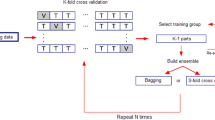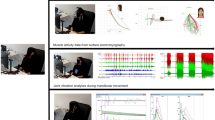Abstract
The objective of the present work was to create an artificial neural network model able to classify individuals suffering from bruxism in clenching and grinding patients according to the value of certain occlusal variables and other parameters. Patients suspected of bruxism represent a very heterogeneous group. Some require immediate treatment while others, with only minor disorders, may not need treatment at all.
Artificial neural network (ANN) ensembles models were trained on with data from 325 bruxist patients examined at the Department of Prosthodontics and Occlusion (Craniomandibular Dysfunction Unit) of Oviedo University. The information retrieved from each patient included some occlusal variables and other information such as their gender and age. The models were analysed using Receiver Operating Characteristics (ROC) curve analysis, calibration assessments, inter- and intra-method variations. Effective odds ratios for the ANN ensembles were compared between each model.
The ANN ensemble approach resulted in an area under the ROC curve of 86%. At 95% sensitivity the specificity was 84.1%, for the existence of 43.5% of bruxists clenching patients in the population of the study. This population corresponds to a grinding patients’ best predictive value of 97.2% and a clenching patients’ best predictive value of 89.5% both using the bagging method. The artificial neural network model obtained can distinguish between clenching and grinding patients requiring the analysis of a few variables and with a high rate of success.
Access this chapter
Tax calculation will be finalised at checkout
Purchases are for personal use only
Similar content being viewed by others
References
Kalamir, A., Pollard, H., Vitiello, A.L., Bonello, R.: TMD and the problem of bruxism. A review. J. Bodyw. Mov. Therapies 11, 183–193 (2007)
Dorland, W.A.N.: Dorland’s Illustrated Medical Dictionary. Elsevier-Saunders, Philadelphia (2003)
Klineberg, I.: Occlusion: Principles and Treatment. Wright, Oxford (1999)
Pergamalian, S.A., Rudy, T.E., Zaki, H.S., Greco, C.M.: The association between wear facets, bruxism, and severity of facial pain in patients with temporomandibular disorders. J. Prosthet. Dent. 90, 194–200 (2003)
Helkimo, M.: Studies on function and dysfunction of the masticatory system. II. Index for anamnestic and clinical dysfunction and occlusal state. Svensk tandlakare tidskrift 67, 101–121 (1974)
Dworkin, S.F., LeResche, L.: Research diagnostic criteria for temporomandibular disorders: review, criteria, examinations and specifications, critique. J. Craniomandib. Disorders 6, 301–355 (1992)
Fu, K., Ma, X., Zhang, Z., Tian, Y., Zhou, Y., Zhao, Y.: Study on the use of temporomandibular joint dysfunction index in temporomandibular disorders. Zhonghua Kou Qiang Yi Xue Za Zhi 37, 330–332 (2002)
Živko-Babić, J., Lisjak, D., Ćurković, L., Jakovac, M.: Estimation of chemical resistance of dental ceramics by neural networks. Dent. Mater. 24, 18–27 (2008)
Fernández, J.R.A., Muñiz, C.D., Nieto, P.J.G., de Cos Juez, F.J., Lasheras, F.S., et al.: Forecasting the cyanotoxins presence in fresh waters: a new model based on genetic algorithms combined with the MARS technique. Ecol. Eng. 53, 68–78 (2013)
de Cos Juez, F.J., Suárez-Suárez, M.A., Lasheras, F.S., Murcia-Mazón, A.: Application of neural networks to the study of the influence of diet and lifestyle on the value of bone mineral density in post-menopausal women. Math. Comput. Model. 54(7), 1665–1670 (2011)
Rokach, L.: Ensemble-based classifiers. Artif. Intell. Rev. 33, 1–39 (2010)
De Bock, K.W., Coussement, K., Van den Poel, D.: Ensemble classification based on generalized additive models. Comput. Stat. Data Anal. 54, 1535–1546 (2010)
Basden, A.G., Atkinson, D., Bharmal, N.A., Bitenc, U., Brangier, M., Buey, T., et al.: Experience with wavefront sensor and deformable mirror interfaces for wide-field adaptive optics systems. Mon. Not. R. Astron. Soc. 459(2), 1350–1359 (2016)
Vilán, J.A.V., Fernández, J.R.A., Nieto, P.J.G., Lasheras, F.S., de Cos Juez, F.J.: Support vector machines and multilayer perceptron networks used to evaluate the cyanotoxins presence from experimental cyanobacteria concentrations in the Trasona reservoir (Northern Spain). Water Resour. Manage. 27(9), 3457–3476 (2013)
De Andrés, J., Sánchez-Lasheras, F., Lorca, P., de Cos Juez, F.J.: A hybrid device of Self Organizing Maps (SOM) and Multivariate Adaptive Regression Splines (MARS) for the forecasting of firms’ bankruptcy. Account. Manage. Inf. Syst. 10(3), 351 (2011)
Chen, H., Xu, Y., Ma, Y., Ma, B.: Neural network ensemble-based computer-aided diagnosis for differentiation of lung nodules on CT images. Clinical Eval. Academic Radiol. 17, 595–602 (2010)
Menéndez, L.Á., de Cos Juez, F.J., Lasheras, F.S., Riesgo, J.A.Á.: Artificial neural networks applied to cancer detection in a breast screening programme. Math. Comput. Model. 52(7), 983–991 (2010)
Chawla, N.V., Moore, T.E., Hall, L.O., Bowyer, K.W., Kegelmeyer, W.P., Springer, C.: Distributed learning with bagging-like performance. Pattern Recogn. Lett. 24, 455–471 (2003)
Green, M., Björk, J., Hansen, J., Ekelund, U., Edenbrandt, L., Ohlsson, M.: Detection of acute coronary syndromes in chest pain patients using neural network ensembles. In: Fonseca, J.M. (ed.) Proceedings of the Second International Conference on Computational Intelligence in Medicine and Healthcare, Lisbon. IEE/IEEE (2005)
West, D., Mangiameli, P., Rampal, R., West, V.: Ensemble strategies for a medical diagnostic decision support system: a breast cancer diagnosis application. Eur. J. Oper. Res. 162, 532–551 (2005)
Levinkind, M.: A dental application of neural network computing: classification of complex electrical impedance measurements to aid root canal treatment. Neural Comput. Appl. 2(4), 209–215 (1994). https://doi.org/10.1007/BF01414809
Azar, A.T.: Fast neural network learning algorithms for medical applications. Neural Comput. Appl. 23(3–4), 1019–1034 (2013). https://doi.org/10.1007/s00521-012-1026-y
Hanley, J.A., Mcneil, B.J.: The meaning and use of the area under a receiver operating characteristic (ROC) curve. Radiology 143, 29–36 (1982)
Manfredini, D., Landi, N., Romagnoli, M., Bosco, M.: Psychic and occlusal factors in bruxers. Aust. Dent. J. 49, 84–89 (2004)
Karasekreter, N., Başçiftçi, F., Fidan, U.: A new suggestion for an irrigation schedule with an artificial neural network. J. Exp. Theor. Artif. Intell. 25(1), 93–104 (2013). https://doi.org/10.1080/0952813X.2012.680071
Tarassenko, L., Whitehouse, R., Gasparini, G., Harris, A.L.: Neural network prediction of relapse in breast cancer patients. Neural Comput. Appl. 4(2), 105–113 (1996)
Author information
Authors and Affiliations
Corresponding author
Editor information
Editors and Affiliations
Rights and permissions
Copyright information
© 2018 Springer International Publishing AG
About this paper
Cite this paper
Álvarez-Arenal, Á., deLlanos-Lanchares, H., Martin-Fernandez, E., González-Gutiérrez, C., Mauvezin-Quevedo, M., de Cos Juez, F.J. (2018). An Artificial Neural Network Model for the Prediction of Bruxism by Means of Occlusal Variables. In: Pérez García, H., Alfonso-Cendón, J., Sánchez González, L., Quintián, H., Corchado, E. (eds) International Joint Conference SOCO’17-CISIS’17-ICEUTE’17 León, Spain, September 6–8, 2017, Proceeding. SOCO ICEUTE CISIS 2017 2017 2017. Advances in Intelligent Systems and Computing, vol 649. Springer, Cham. https://doi.org/10.1007/978-3-319-67180-2_36
Download citation
DOI: https://doi.org/10.1007/978-3-319-67180-2_36
Published:
Publisher Name: Springer, Cham
Print ISBN: 978-3-319-67179-6
Online ISBN: 978-3-319-67180-2
eBook Packages: EngineeringEngineering (R0)




